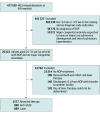Pulmonary Hypertension in Preterm Infants Treated With Laser vs Anti-Vascular Endothelial Growth Factor Therapy for Retinopathy of Prematurity
- PMID: 36201183
- PMCID: PMC9539731
- DOI: 10.1001/jamaophthalmol.2022.3788
Pulmonary Hypertension in Preterm Infants Treated With Laser vs Anti-Vascular Endothelial Growth Factor Therapy for Retinopathy of Prematurity
Abstract
Importance: Anti-vascular endothelial growth factor (VEGF) therapy for retinopathy of prematurity (ROP) has potential ocular and systemic advantages compared with laser, but we believe the systemic risks of anti-VEGF therapy in preterm infants are poorly quantified.
Objective: To determine whether there was an association with increased risk of pulmonary hypertension (PH) in preterm infants with ROP following treatment with anti-VEGF therapy as compared with laser treatment.
Design, setting, and participants: This multicenter retrospective cohort study took place at neonatal intensive care units of 48 children's hospitals in the US in the Pediatric Health Information System database from 2010 to 2020. Participants included preterm infants with gestational age at birth 22 0/7 to 31 6/7 weeks who had ROP treated with anti-VEGF therapy or laser photocoagulation.
Exposures: Anti-VEGF therapy vs laser photocoagulation.
Main outcomes and measures: New receipt of pulmonary vasodilators at least 7 days after ROP therapy was compared between exposure groups, matched using propensity scores generated from preexposure variables, and adjusted for birth year and hospital. The odds of receiving an echocardiogram after 30 days of age was also included to adjust for secular trends and interhospital variation in PH screening.
Results: Among 1577 patients (55.9% male) meeting inclusion criteria, 689 received laser photocoagulation and 888 received anti-VEGF treatment (95% bevacizumab, 5% ranibizumab). Patients were first treated for ROP at median 36.4 weeks' postmenstrual age (IQR, 34.6-38.7). A total of 982 patients (491 in each group) were propensity score matched. Good covariate balance was achieved, as indicated by a model variance ratio of 1.15. More infants who received anti-VEGF therapy were treated for PH, but when adjusted for hospital and year, this was no longer statistically significant (6.7%; 95% CI, 2.6-6.9 vs 4.3% 95% CI, 4.4-10.2; adjusted odds ratio, 1.62; 95% CI, 0.90-2.89; P = .10).
Conclusions and relevance: Anti-VEGF therapy was not associated with greater use of pulmonary vasodilators after adjustment for hospital and year. Our findings suggest exposure to anti-VEGF may be associated with PH, although we cannot exclude the possibility of residual confounding based on systemic comorbidities or hospital variation in practice. Future studies investigating this possible adverse effect seem warranted.
Conflict of interest statement
Figures



Comment in
-
Pulmonary Hypertension and Anti-Vascular Endothelial Growth Factor Therapy for Retinopathy of Prematurity-Is There a Link?JAMA Ophthalmol. 2022 Nov 1;140(11):1094-1095. doi: 10.1001/jamaophthalmol.2022.3824. JAMA Ophthalmol. 2022. PMID: 36201187 No abstract available.
-
Is Anti-Vascular Growth Factor Therapy for Retinopathy of Prematurity Associated With Pulmonary Hypertension?JAMA Ophthalmol. 2023 Apr 1;141(4):407. doi: 10.1001/jamaophthalmol.2023.0015. JAMA Ophthalmol. 2023. PMID: 36862391 No abstract available.
-
Is Anti-Vascular Growth Factor Therapy for Retinopathy of Prematurity Associated With Pulmonary Hypertension?-Reply.JAMA Ophthalmol. 2023 Apr 1;141(4):408-409. doi: 10.1001/jamaophthalmol.2023.0009. JAMA Ophthalmol. 2023. PMID: 36862400 No abstract available.
-
Is Anti-Vascular Growth Factor Therapy for Retinopathy of Prematurity Associated With Pulmonary Hypertension?JAMA Ophthalmol. 2023 Apr 1;141(4):406-407. doi: 10.1001/jamaophthalmol.2023.0012. JAMA Ophthalmol. 2023. PMID: 36862404 No abstract available.
-
Is Anti-Vascular Growth Factor Therapy for Retinopathy of Prematurity Associated With Pulmonary Hypertension?JAMA Ophthalmol. 2023 Apr 1;141(4):407-408. doi: 10.1001/jamaophthalmol.2023.0018. JAMA Ophthalmol. 2023. PMID: 36862405 No abstract available.
Similar articles
-
Retinal Detachment after Treatment of Retinopathy of Prematurity with Laser versus Intravitreal Anti-Vascular Endothelial Growth Factor.Ophthalmology. 2021 Aug;128(8):1188-1196. doi: 10.1016/j.ophtha.2020.12.028. Epub 2020 Dec 31. Ophthalmology. 2021. PMID: 33387554 Free PMC article.
-
Term infant brain MRI after ROP treatment by anti-VEGF injection versus laser therapy.J AAPOS. 2024 Dec;28(6):104038. doi: 10.1016/j.jaapos.2024.104038. Epub 2024 Nov 14. J AAPOS. 2024. PMID: 39550050
-
Effect of Intravitreal Aflibercept vs Laser Photocoagulation on Treatment Success of Retinopathy of Prematurity: The FIREFLEYE Randomized Clinical Trial.JAMA. 2022 Jul 26;328(4):348-359. doi: 10.1001/jama.2022.10564. JAMA. 2022. PMID: 35881122 Free PMC article. Clinical Trial.
-
The Male to Female Ratio in Treatment-Warranted Retinopathy of Prematurity: A Systematic Review and Meta-analysis.JAMA Ophthalmol. 2022 Nov 1;140(11):1110-1120. doi: 10.1001/jamaophthalmol.2022.3988. JAMA Ophthalmol. 2022. PMID: 36201195 Free PMC article.
-
The efficacy and ocular safety following aflibercept, conbercept, ranibizumab, bevacizumab, and laser for retinopathy of prematurity: a systematic review and meta-analysis.Ital J Pediatr. 2023 Oct 9;49(1):136. doi: 10.1186/s13052-023-01543-3. Ital J Pediatr. 2023. PMID: 37814332 Free PMC article.
Cited by
-
Alpha-1 antitrypsin reduces inflammation and vasculopathy in mice with oxygen-induced retinopathy.J Inflamm (Lond). 2025 Feb 11;22(1):6. doi: 10.1186/s12950-025-00431-3. J Inflamm (Lond). 2025. PMID: 39934776 Free PMC article.
-
How can the safety of antibody therapy for retinopathy of prematurity be improved?Expert Rev Ophthalmol. 2023;18(2):97-99. doi: 10.1080/17469899.2023.2200934. Epub 2023 Apr 9. Expert Rev Ophthalmol. 2023. PMID: 37485085 Free PMC article. No abstract available.
-
Prevention of Chronic Morbidities in Extremely Premature Newborns with LISA-nCPAP Respiratory Therapy and Adjuvant Perinatal Strategies.Antioxidants (Basel). 2023 May 24;12(6):1149. doi: 10.3390/antiox12061149. Antioxidants (Basel). 2023. PMID: 37371878 Free PMC article. Review.
-
Laser versus Anti-VEGF: A Paradigm Shift for Treatment-Warranted Retinopathy of Prematurity.Ophthalmol Ther. 2023 Oct;12(5):2241-2252. doi: 10.1007/s40123-023-00744-7. Epub 2023 Jun 19. Ophthalmol Ther. 2023. PMID: 37337024 Free PMC article. Review.
-
Biglycan stimulates retinal pathological angiogenesis via up-regulation of CXCL12 expression in pericytes.FASEB J. 2025 Jan 15;39(1):e70262. doi: 10.1096/fj.202401903R. FASEB J. 2025. PMID: 39760177 Free PMC article.
References
-
- VanderVeen DK, Melia M, Yang MB, Hutchinson AK, Wilson LB, Lambert SR. Anti-vascular endothelial growth factor therapy for primary treatment of type 1 retinopathy of prematurity: a report by the American Academy of Ophthalmology. Ophthalmology. 2017;124(5):619-633. doi:10.1016/j.ophtha.2016.12.025 - DOI - PubMed
MeSH terms
Substances
LinkOut - more resources
Full Text Sources
Medical

